Top News
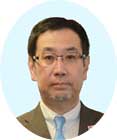
December 9, 2014 4 Wu Li Jun of the Ryukyu Shimpo
Consultant of the Worldwide Uchinanchu Business Association, Yoshikazu Higashi, who is also president of the Okinawa Tourist Service, will take up a post as the new president of the organization on January 1 next year. The current president Tameyasu Nagamine will become the next consultant of the WUB.
The Worldwide Uchinanchu Business Association (WUB) is a non-profit organization established for strengthening partnership among Okinawan business people throughout the world.
Higashi, who will be the sixth president of the organization, worked as the president of the Okinawa branch of the WUB from September 2006 to June 2013. The chief of the secretariat of the WUB Mariko Kuniyoshi said, “Higashi is energetic and influential, and will be a big force for the Worldwide Uchinanchu Festival, which will be held in 2016.”
The WUB was established as “WUB International” in 1997. The organization changed its name to the current one in 2008. Its headquarters is located in Hawaii. The organization has 22 branches in 16 countries and regions around the world with 500 members.
(English translation by T&CT)
Go to Japanese
December 11, 2014 Ryukyu Shimpo
A 67-year-old-man who had been riding a mini-bike on Prefectural Road 75 in Okinawa City was found lying unconscious on the road after a hit and run on December 4. The man was taken to a hospital where he remains in serious condition. The Okinawa Prefectural Police announced that a Marine Corps major assigned to Camp Courtney was involved in the accident. According to police, they matched a side mirror found at the scene to the marine’s car. As of December 10, the victim remained unconscious in a local hospital.
Police report the suspect admitted his involvement in the hit-and-run accident, telling them that he fled out of fear. They do not intend to seek custody and continue to conduct the criminal investigation of the incident on a non-compulsory basis. Police say they do not see any risk of the marine escaping and covering his tracks. They will soon give prosecutors the files on him regarding suspected violation of the law on motor vehicle operators (accidental infliction of injury) and Road Traffic Law (failure to report an accident and follow the duty of giving aid to victims). The suspect has been in U.S. military custody since December 10.
According to police, the suspect was driving from the direction of Goya Intersection on the Prefectural Road 75 in Okinawa City toward Uruma City around 5 p.m. on December 4. Allegedly, the left part of his car collided with the mini-bike ahead. The victim fell down and hit his head on the road, and was later brought to a hospital in the central part of Okinawa, where he remains unconscious. The suspect was on his way to Camp Courtney, where he works, from his home at the U.S. Marines’ Camp Kinser. According to police, there has been no indication the driver was under the influence of alcohol.
From security camera footage, the police identified the suspect’s car missing its left side mirror, driving in the area of the accident.
On December 15, the Okinawa Prefectural Assembly held a special committee related to U.S.military bases, and asked how the prefectural government and police would deal with the incident.
(English translation by T&CT)
Go to Japanese
December 16, 2014 Ryukyu Shimpo
Four candidates opposing construction of a new base have won the Okinawan seats in the House of Representatives election, in yet another clear statement of Okinawan people’s will. The winners are from the bipartisan forces that secured Takeshi Onaga’s post as governor, and oppose the relocation of U.S. Marine Corp Air Station Futenma within Okinawa. All four of the Liberal-Democratic Party’s candidates, who reneged on their pledges to move the base outside Okinawa, and backed the government’s push for the Henoko relocation, were defeated in the election. The outcome in Okinawa is at odds with the national result, which saw LDP-backed candidates overwhelm their rivals nationwide.
It confirmed a historical turning point. In the Nago Mayoral election, the gubernatorial race, and now the House of Representatives election, the Okinawan people have shown that they are moving beyond the old conservative- versus-progressive politics and uniting in their rejection of an unreasonable U.S. base-hosting burden. It is the first time Okinawans have universally refused to sacrifice themselves for the main islands of Japan.
The central government’s dismissive attitude toward Okinawa
Prime Minister Shinzo Abe has quickly dismissed the election results in Okinawa, and showed his intention to force through building the new base, saying, “We would like to promote the Henoko relocation while soundly explaining this to Okinawan people.” On the next day, Chief Cabinet Secretary Yoshihide Suga said, “Although we accept the defeats of all the LDP-backed candidates in Okinawa, we would like to carry out the relocation work straightforwardly and following legislation.”
It appears that they do not feel the need to have any regard for Okinawan people’s will.
They appear to see Okinawa as their territory, where they would like to put U.S military bases, and think Okinawan people are a hindrance to what they want to do.
Is there any difference between what the Japanese government has been doing against Okinawan people and what the Chinese government has been doing against the people of Xinjiang Uyghur Autonomous Region and Hong Kong’s pro-democracy ‘Occupy’ protests?
The problem is, the idea of thrusting the U.S military bases onto Okinawa is not unique to the Abe administration.
Some opinion polls have suggested that 70 to 80 percent of Okinawan people have always been against the Henoko relocation, while people in the other parts of Japan have supported the plan to build the new base in Okinawa.
The idea that Okinawa is the most adequate area to place the U.S Marines, is widely accepted among Japanese. However, it is just a perception.
Based on strategic mobility, placing the marines in Northern Kyushu is more reasonable. In fact, the U.S government asked to transfer the Marine Corps from Okinawa to the main islands of Japan in 1996 when the U.S base issue was in the spotlight, and in 2005 when the U.S . and Japanese governments discussed the realignment of U.S forces in Japan. However, the Japanese government rejected the proposal to transfer the marines from Okinawa to other parts of the main islands of Japan.
Some say that Japan needs to keep the U.S Marines Corps in Okinawa because of the Senkaku/Diaoyu dispute. This idea is wrong too. According to formal documents written by Washington and Tokyo foreign affairs and defense bureaucrats, Japan has to defend the islands in the southwestern area of Japan by itself. The U.S military forces will not play a part in defending Japan in the dispute.
Most of the media in the main islands of Japan have not reported this. While the major media outlets in Japan are responsible for this lack of reporting, the Japanese people have also averted their eyes from a “truth” they do not want to face. Is it an overstatement to say that Japanese people in the mainland prefectures unconsciously think that they do not want the U.S bases close to them and want Okinawa to accept them? It is this kind of thinking that leads us to conclude that not only the Abe administration but also Japanese people in general are happy to sacrifice Okinawa and force the prefecture to bear the base-hosting burden.
Divide and conquer; Okinawan community still at risk of division
With support from bipartisan forces, both Takeshi Onaga won the gubernatorial race, and all the four candidates won the Lower House election. These politicians have had to try to resist the central government and Japanese people willfully thrusting the U.S military bases onto Okinawa without regard for Okinawan people.
Compensating for this devaluing of Okinawan interests is not an easy task.
What worries us is a rift among Okinawan people.
The Japanese government treats Okinawa as its colony by ignoring the will of the people. History tells us that colonial masters are happy when civilians in their colonies are divided. That’s why the colonial masters always try to divide the colonized people and rule them by giving their figureheads preferential treatment.
The strange thing in this election is that all the candidates who lost in single-seat electoral districts, won seats under the proportional representation system. It is safe to say the problems of the current Japanese election system have been underlined because candidates who failed to get voters’ support won the seats.
The LDP-backed candidates who won seats under the proportional representation system, will face a choice from now on. They have to decide whether they will be a spokesperson for the Japanese government or a voice to convey the will of the Okinawan people to the governments of Japan and the United States. In other words, they have to decide whether they will become the “colonized elite,” allowing Okinawa’s interests to be subsumed into those of the main islands of Japan, or proud envoys, advancing Okinawa’s right to self-determination.
The answer is clear. We would like the new governor and the new lower house members in Okinawa to unite again and work together to try to compensate for the deficit in justice and morale being afforded to the Okinawan people by the central government and Japanese population, who are thrusting the U.S military bases onto Okinawa.
(English translation by T&CT)
Go to Japanese
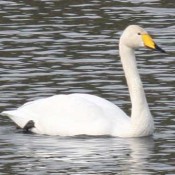
December 2, 2014 Ryukyu Shimpo
On November 30, a whooper swan was observed for the first time in Ogimi resting at Taiho dam.
Whooper swans come to Japan as winter birds, and they are often observed in Hokkaido and Tohoku regions. It is rare to find them in Okinawa. Masakuni Yamashiro, a chair of Okinawa Wild Bird Society said, “Whooper swans visited Nago before, but it is first time to find them in Ogimi. I am worried about swans flying to Okinawa because they often have a hard time finding food and loose energy. I hope they gain energy during winter in Okinawa and fly back home safely.”
(English translation by T&CT, Hitomi Shinzato)
Go to Japanese

December 7, 2014 Ryukyu Shimpo
The Okinawa Prefectural Peace Memorial Museum held a symposium “Okinawa reflected in the eyes of second-generation Japanese-American Uchinanchu during and after the war” in Itoman on February 6. Takejiro Higa, 91, who served in the Battle of Okinawa in 1945 and called for surrender to residents in Uchinaguchi or Okinawan dialect, and Yoshinobu Oshiro, 86, who served as an interrogator of Japanese soldiers on their return from Siberia, in Maizuru, Kyoto after the end of the war, spoke out about their experiences to about 200 audience members. The two former U.S. soldiers of Okinawan descent stressed that war destroys everything, including people and buildings, and that it should not be allowed to occur again.
The Okinawa Prefectural Government carried out a project of recording the experiences of Japanese Americans, including those of Okinawan descent, who served in the Battle of Okinawa, this year. The symposium is a part of the project. Higa and Oshiro took part in the symposium from Hawaii.
Oshiro, who was born and raised in Hawaii, experienced the Pearl Harbor attack on December 7, 1941. He was enlisted in the U.S. Army in 1946 after the end of the war. When he was assigned as an interpreter-soldier of the CIC in Japan under U.S. military occupation, he undertook interrogation of former Japanese soldiers who had returned from Siberia. In 1947, Oshiro visited for the first time Haebaru Village, the hometown of his parents. “It was the first meeting between us, but his grandmother was willing to hug me. Having seen me in the picture, she recognized me at once. I could only nod to her words because I could not understand Okinawan dialect. I was really happy,” Oshiro said, reflecting on the memory of that time.
Higa was raised in Kitanakagusuku Village, the home of his parents, after he was born in Hawaii. He returned to Hawaii in 1939, avoiding enlistment into the Volunteer Pioneer Youth Army of Manchuria and Mongolia. When he was stationed in Leyte Island, the Philippines, in 1944, he was shocked to see a photograph of Okinawa just after the U.S. military carried out air strikes on October 10. About 90 percent of buildings in Naha City, the capital of Okinawa, were lost to fire and abandonment. “Okinawan relatives and classmates appeared in a dream to me. I was so worried about Okinawa,” he said.
Soon after landing in Okinawa, Higa called out for residents to surrender. “I was struggling physically and emotionally to say it. I did not shoot any bullets. I would be pleased if my work has contributed something to Okinawan people. War destroys everything and it is the most ridiculous thing,” he stressed.
(English translation by T&CT)
Go to Japanese
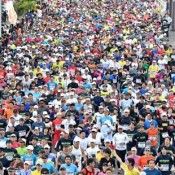
December 8, 2014 Ryukyu Shimpo
The Naha City Government and other organizations held the 30th Naha Marathon on December 7. Participants started in front of Meijibashi intersection on National Route 58 in Naha and ran 42.195 kilometers in the southern part of Okinawa. They finished at Onoyama Athletic Park.
Saitama resident Yuki Kawauchi won the male division with a time of 2 hours 13 minutes 43 seconds, shattering the tournament record. Kawauchi is known as the “citizen runner” because he works full-time for the government of Saitama Prefecture and trains in his time off without any sponsorship. Tokyo resident Mitsuko Hirose won the female-division for the third time in a row.
There were 29,566 applicants for the event, with 26,905 people participating. Of the participants, 19,652 were men and 7,253 were women.
The number of participants who completed the full marathon within the time limit of 6 hours and 15 minutes was 20,029, made up of 15,480 men and 4,549 women. Almost 74 percent of the contestants finished the race, up 4.85 percent from the previous year.
(English translation by T&CT)
Go to Japanese
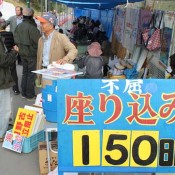
December 4, 2014 Ryukyu Shimpo
Citizens of a sit-in protest in front of the gate of U.S. Marine Camp Schwab marked 150 days since the sit-in began on December 3. They started this action against the construction of a new U.S. air base in Henoko, Nago on July 7. According to calculations by the Ryukyu Shimpo’s reporters, the number of participants in the sit-in protest inside and outside of Okinawa amounts to 18,243 people, including those in the people’ rallies in August and September.
Hiroji Yamashiro, the director of the Okinawa Peace Movement Center, said, “Our struggle came to a stage where the Okinawan Governor was replaced by an opponent of the new U.S. air base. We will continue our movement with confidence. We can stop the construction definitely.”
According to the organizer, the number of participants in the first people’s rally held on August 23 was about 3,600 people and in the second people’s rally on September 20 there were about 5,500 people. The total number of participants in the two rallies was 9,100 people.
Not only residents, but also many students, scholars and artists from other prefectures and abroad visited the sit-in protest, and studied Okinawan problems. Takeshi Onaga, the next governor of Okinawa, Kazuo Shii, the chairman of the Communist Party and many politicians visited the scene to encourage citizens.
Kizo Takagaki, 65, a Motobu resident who has taken part in the sit-in action almost every day, highlighted the significance of the protest. “I have felt deeply the strong desire of the people who are against the base construction, as the days went by at the sit-in,” he said. “We will use our power to support incoming governor Onaga who is opposing the new base construction.”
(English translation by T&CT)
Go to Japanese

December 4, 2014 Ryukyu Shimpo
On December 3, TripAdvisor, the biggest travel website in the world providing travel reviews, announced “Traveler’s Choice 10 Destinations On The Rise in 2014.”
Naha City has ranked 6th in the world ranking, and 4th in the Asian ranking. Naha is the only city in Japan to come top 10 in the list.
The popular tourist spots in Naha are the Okinawa Prefectural Museum, Shurijo Castle, Shikina-en Garden and the stone path in Kinjo Town. The city attracts attention from the world as a place where tourists can experience the history of Ryukyu Kingdom and the modern city of Okinawa.
As well as those from Japan, tourists from the United States and Taiwan offered reviews on Naha. People from various countries are interested in the history of Okinawa.
According to the TripAdvisor report, Takeshi Sakumoto of the Naha City Tourism Association said, “We would like to further improve the hospitality of Naha, continue to establish it as a tourist city that host guests from all over the world, and do our best to attract more tourists.”
In the ranking, Da Nang in Vetnam took first place, followed by Sihanoukville in Cambodia, Limassol in Cyprus, Ao Nang in Thailand, and Bodrum in Turkey.
(English translation by T&CT)
Go to Japanese
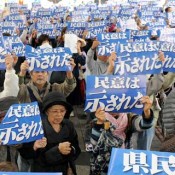
December 5, 2014 Ryukyu Shimpo
Okinawa Governor Hirokazu Nakaima could possibly approve an application submitted by the Okinawa Defense Bureau to change the method used for landfill in Henoko, Nago, where a new U.S. Marine air base is planned to replace the Futenma base in Ginowan. On December 4, citizen groups formed a human chain around the Okinawa Prefectural Government (OPG) buildings in Naha to demonstrate their united opposition to the governor’s approval.
According to the organizers, 2,200 people gathered and requested Nakaima not approve the application during his term of office.
In the rain, the participants held blue signboards bearing the messages, “The result of the Okinawa gubernatorial election showed Okinawan people’s will” and “No to a new base in Henoko.”
Facing the OPG buildings, the citizens voiced their protest, calling for the governor to respect Okinawan people’s will. They said they would not tolerate the betrayal of his reneging on a pledge to move the base outside Okinawa.
The participants raised their voices in protest against the governor’s approval of the application in the final days of his term of office, which ends on December 9.
They declared they would continue to protest against the construction of the new base.
Hiroshi Ashitomi, co-representative of the Helicopter Base Objection Association, said, “We will not allow Nakaima to ignore his historical defeat in the gubernatorial election by a margin of about 100,000 votes.”
At the end of the rally, Ashitomi said, “Nakaima should not approve the application because Okinawan people rejected him based on his approval of the Henoko relocation, which could hugely influence the future of Okinawa. His further betrayal is not tolerated.”
The participants have adopted a resolution to request Nakaima leave the decision on whether to approve the application to the next Governor Takeshi Onaga.
This is the second time citizens have formed a human chain around the OPG buildings since the Japanese government began marine boring investigations in Henoko this August.
(English translation by T&CT)
Go to Japanese
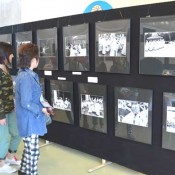
December 3, 2014 Ryukyu Shimpo
From November 22 to 24 at Ganju Station Nanjo in Chinen Kudeken, the Nanjo City Tourism Association held a special exhibition “Kudaka Island Izaiho Exhibition – Hope and Appreciation woven by Kaminchu.” The exhibit presented pictures and films, which documented a sacred Izaiho ceremony, which ceased as of 1978. It also displayed attires, which kaminchu (sacred women) wore for a ceremony. The event attracted many visitors.
Izaiho is a ceremony for women who are between the ages of 30 and 41, born and raised in Kudaka Island, and married to men from the island. It initiates them as kaminchu. The ceremony is held on the island for four days from November 15 of the year of the horse in the lunar calendar. This year is an Izaiho year. However, the ceremony was canceled due to an absence of women who meet the criteria.
The exhibition introduces the process of the four-day ceremony with pictures and screens that document ceremonies held in 1966 and 1978. A golden jewel excavated from Sefa Utaki and replicas of Kikoeogimi’s (goddess in Ryukyuan mythology) costume are also displayed.
The Kudaka Island Products expo was also held at the venue on the same day. Yoko Fukuji and Setsuko Kohagura, who took part in Izaiho in 1978, sold homemade irabu-jiru or sea snake soup. Fukuji said, “It is sad that Izaiho will cease, but we cannot adjust the rules and lie to God. This is something we cannot help. It is great that photos and films are there. I hope many people will see them.”
On November 23, Professor Masanobu Akamine from the University of the Ryukyus gave a lecture.
(English translation by T&CT and Megumi Chibana)
Go to Japanese
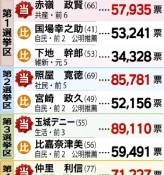
December 14, 2014 Ryukyu Shimpo
Four candidates opposing construction of a new base won the Okinawan seats in the House of Representatives election on December 14. Following the election of a base-opposed governor in November, the issue of relocating U.S. Marine Corp Air Station Futenma in Ginowan to Henoko, Nago, became the major focal point of the national election. The election was contested between the Liberal-Democratic Party’s candidates, who back the government’s push for the Henoko relocation, and nonpartisan candidates who supported the elected Governor Takeshi Onaga’s stance against the new air base in the gubernatorial race.
In the 1st district, Seiken Akamine, 66, former member of the House of Representatives who represents the Communist Party, was elected. He was elected in the proportional representation system in the previous general elections. He became the first winning candidate of the Communist Party in the 1st district under the single-seat constituency system introduced in 1996. He is also the first winning candidate from the Communist Party in 18 years across the country.

Seiken Akamine
Akamine has received the support from the bipartisan forces that promoted Onaga to the post of governor. With the help of Governor Onaga, the candidate for the communist party gained a wide-range of support from other opposition parties and independents. He succeeded in gaining the votes of conservative and centrist parties.
Former chairman of the Okinawa Prefectural Assembly Toshinobu Nakazato, 77, an independent candidate, won the seat in the 4th district. He campaigned on his partnership with Governor Onaga. Former House of Representatives member Kantoku Teruya, 69, from the Social-Democratic Party, won the seat in the 2nd district. Former House of Representatives member Denny Tamaki, 55, Seikatsu no To (People’s Life Party) was elected in the 3rd district. He was elected in the proportional representation system in the previous election. The 2nd district includes the area where the Futenma base is located, and the 3rd district includes the relocation site in Henoko, Nago.

Kantoku Teruya
All four candidates of the ruling LDP Kosaburo Nishime, 60, Konosuke Kokuba, 41, Masahisa Miyazaki, 49, and Natsumi Higa, 56, lost to their rivals. But all of them succeeded in winning parliamentary seats under the proportional representation system. Former State Minister in Charge of Postal Services Privatization Mikio Shimoji, 53, Ishin no To (Japan Innovation Party) who lost in the 1st district and former House of Representatives member Kiyohiko Toyama, 45, Komeito Party, won seats under the proportional representation system.
(English translation by T&CT)

Denny Tamaki

Toshinobu Nakazato

Konosuke Kokuba

Kosaburo Nishime

Natsumi Higa

Masahisa Miyazaki

Mikio Shimoji

Kiyohiko Toyama



















 Webcam(Kokusai Street)
Webcam(Kokusai Street)


